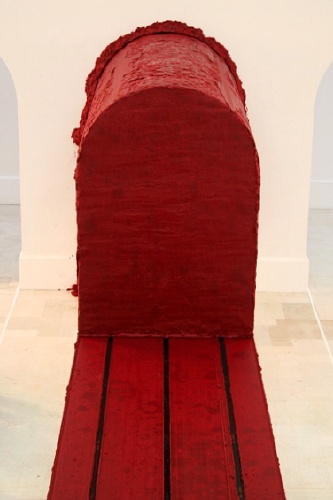Anish Kapoor
Celebrated for his gigantic, stainless steel Cloud Gate sculpture in Chicago’s Millennium Park, Anish Kapoor is changing the cultural environment with his public works.
1.Research Kapoor's work in order to discuss whether it is conceptual art or not. Explain your answer, using a definition of conceptual art.
"Conceptual Art" is a contemporary form of artistic representation, in which a specific concept or idea, often personal, complex and inclusive, takes shape in an abstract, nonconforming manner, based upon a negation of aesthetic principles.
Kapoor's work belong to conceptual art because what all he did concept ideas more important than the work's meaning. Like the work "Cloud Gate" does not harbor some technologically advanced monster, but rather draws in the surrounding beauty, it's the artist representation how the architecture of the clouds and the buildings attract the people who come to visit it.
2. Research 3 quite different works by Kapoor from countries outside New Zealand to discuss the ideas behind the work. Include images of each work on your blog.
ArcelorMittal Orbit
As Lakshmi Mittal, CEO of ArcelorMittal, commented: “We set out to create a transformational piece of art that will be an iconic symbol for the Olympics and also a new landmark that will endure long after the Games themselves. Everyone at ArcelorMittal is delighted with the outcome of the ArcelorMittal Orbit. London will have a bold, beautiful and magnificent sculpture that also showcases the great versatility of steel.”
Yellow, 1999
Fibreglass and pigment
600 x 600 x 300 cm
Courtesy the artist and Lisson Gallery, London
Installation: Haus der Kunst, Munich, 2007-08
Photo: Erika Ede © FMGB Guggenheim Bilbao Museoa, 2010
Yellow is a monumental and arresting work. Here Anish Kapoor uses colour as an autonomous tool: it embraces and subverts form. A great gaping belly recedes deep into the wall. Kapoor has a deep interest in the use of varying tones of a single colour. I can see him explore its sculptural and metaphysical possibilities again and again in his work. Also I admired how the colour changed just like Anish Kapoor described : the idea that in monochrome there is no composition, there is only a kind of ‘witness’. We want to make colour such that it is a condition so absolute and complete that it’s rather like water is wet. Yellow should be yellow or red should be red. There, total. What that does, or what that can do (as we know from Barnett Newman, who was a great hero of mine...) is that it can change time.
With Yellow, our eyes begin to operate in a similar way: - they pull in and push out. We find we are as drawn to the overwhelming strength of the colour as much as to the void at the centre of the work. This is the amazing way artists to express their ideas.
Anish Kapoor, Svayambh, 2007
"Svayambh" is a deep red, wax-like block that will be moving almost imperceptibly along a set of tracks, which reach from one end of the entire eastern galleries to the other. Its appearance which is reminiscent of a train can be related back to Kapoor’s fascination with Andrei Konchalovsky’s film "Runaway Train" (1985), where two escaped convicts and a female railway worker find themselves trapped on a train with no brakes and nobody driving. Creating a red line through the building, "Svayambh" passes through two doorways, which form and seemingly force the block through their restrictive frames making it leave behind smeary traces of its material: a mixture of Vaseline, paint and wax.
This enormous red mass reminiscent of compacted blood evokes an almost apocalyptic image. Interestingly a red heifer or "parah adumah" notably adom means red and dam means blood in Hebrew is often associated with the Apocalypse in Judaism. "Svayambh" can be seen in direct correlation to a further site-specific work, a "wound" or slit of about 1,5 m that Kapoor will carve directly into a wall.
This enormous red mass reminiscent of compacted blood evokes an almost apocalyptic image. Interestingly a red heifer or "parah adumah" notably adom means red and dam means blood in Hebrew is often associated with the Apocalypse in Judaism. "Svayambh" can be seen in direct correlation to a further site-specific work, a "wound" or slit of about 1,5 m that Kapoor will carve directly into a wall.
3.Discuss the large scale 'site specific' work that has been installed on a private site in New Zealand.



Site-specific art is artwork created to exist in a certain place. Typically, the artist takes the location into account while planning and creating the artwork. Kapoor’s first outdoor Site-specific art sculpture in fabric, “The Farm” (the sculpture is named after its site), is designed to withstand the high winds that blow inland from the Tasman Sea off the northwest coast of New Zealand’s North Island.
The ellipses are orientated one horizontal, the other vertical. Thirty-two longitudinal mono-filament cables provide displacement and deflection resistance to the wind loads while assisting with the fabric transition from horizontal ellipse, to a perfect circle at midspan, through to the vertical ellipse at the other end. The sculpture, which passes through a carefully cut hillside, provides a kaleidoscopic view of the beautiful Kaipara Harbor at the vertical ellipse end and the hand contoured rolling valleys and hills of “The Farm” from the horizontal ellipse.
4. Where is the Kapoor's work in New Zealand? What are its form and materials? What are the ideas behind the work?
Kapoor has also completed the massive Dismemberment Site 1, installed in New Zealand on the private "art park" known as "The Farm" and owned by New Zealand businessman and art patron Alan Gibbs.
The sculpture is fabricated in a custom deep red PVC-coated polyester fabric by Ferrari Textiles supported by two identical matching red structural steel ellipses that weigh 42,750kg each. The fabric alone weighs 7,200kg.
The ideas behind the work is "passage", giving the singular impression we can enter it to discover an unknown "elsewhere".
5. Comment on which work by Kapoor is your favourite, and explain why. Are you personally attracted more by the ideas or the aesthetics of the work?
"The farm" is my favourite because I went to the Gibbs farm and closely had look around it, the sculpture in the photos looks small but in reality this art work is spectacular. It looks like a staircase leads to two worlds but still can contact each other through the horn.
Youtube has some excellent footage on Kapoor-take a look at Anish Kapoor at the Royal Academy.
Youtube has some excellent footage on Kapoor-take a look at Anish Kapoor at the Royal Academy.
www.royalacademy.org.uk ›
http://www.robgarrettcfa.com/thefarm.htm
http://www.billslater.com/cloudgate/
http://www.robgarrettcfa.com/thefarm.htm
http://www.billslater.com/cloudgate/
 | ||||||
http://www.guggenheim-bilbao.es/microsites/anish_kapoor/secciones/galeria_imagenes/galeria_imagenes_detalle.php?idioma=en&id_imagen=27 |
http://www.dezeen.com/2010/03/31/arcelormittal-orbit-by-anish-kapoor/http://www.caroun.com/art/conceptualart/conceptualart.html
http://litmed.med.nyu.edu/Annotation?action=view&annid=10411





















